Pentax Q - the smallest system camera
Pentax Q review
Pentax Q review – test of a compact mirrorless camera with interchangeable lenses, technical specifications, functions, reviews and impressions, test images.
Pentax Q (“Q”) is the world’s smallest system camera with interchangeable lenses. Sensor with back-illuminated BSI-CMOS resolution 12 MP format 1/2.3” (6.17×4.55 mm), new Q-mount, magnesium alloy body, 3” monitor with 460,000 dots resolution, sensor-shift optical image stabilizer and dust removal, built-in flash and external flash connector (also used for optical viewfinder), PASM modes, ISO sensitivity range 125-6400, 5fps continuous shooting, RAW format support (DNG 12-bit), digital filters and effects, HDR shooting with auto-stitch , Full HD video [email protected] (H.264), infrared remote control (sensors on the front and rear panels).

BRIEF CHARACTERISTICS
98x58x31 mm (manufacturer's data, body without lens and protruding parts)
104x58x35 mm (body dimensions, our measurements)
104x58x57 mm (dimensions with 8.5/1.9 lens, our measurements)
| Matrix | 12.4 MP; 4000×3000; 1/2.3” (6.17x4.55 mm) |
| Lens | Pentax Q systems, focal length ratio 5.53x. The test included a standard 8.5mm/1.9 prime lens, as well as a 6.3mm/7.1 Toy Lens Wide and an 18mm/8 Toy Lens Telephoto. |
| Carrier | SD/SDHC/SDXC memory cards |
| Monitor | 3.0″, 460000 dots |
| File Format | RAW (DNG), JPEG, RAW+JPEG; video – MPEG-4 (MOV) up to 1920x1080p at 30 fps, mono audio |
| Connection | Combined AV output/USB, mini-HDMI, IR remote control |
| Dimensions | |
| Position in the lineup | N/A – Pentax Q – N/A |
Mirrorless system cameras today are produced by most leading photographic equipment manufacturers - Nikon, Olympus, Panasonic, Pentax, Samsung, Sony. Until recently, when talking about such cameras, we called their distinctive features the following:
- the absence of a mirror and pentaprism, as a result of which the body dimensions are significantly smaller than those of SLR cameras, however, viewing is carried out not through an optical viewfinder, but using electronic monitors;
- interchangeable lenses - which means the ability to install the most suitable lens for the current task;
- a large matrix, potentially capable of providing higher image quality than the small matrices of conventional compacts.
However, the appearance of the Pentax Q model introduced some confusion into this harmonious classification. The first two of the three points are completely true about her; Moreover, in terms of miniature size, the Pentax Q breaks all records among system cameras with interchangeable lenses (in the illustration below, the Pentax Q is shown in the same scale as the Sony Alpha NEX-5N model).
However, with regard to the third point, Pentax Q occupies a special position - its matrix is by no means “mirror” size. In fact, matrices of this format (1/2.3″) are used specifically in compact cameras, and more likely in low-end rather than top-end models.

However, if you look even at the short list of technical parameters and capabilities of the camera with which we started this review, you cannot help but feel respect for the little Q. She no longer seems like a toy; everything looks more than serious. It seems that the Pentax developers managed to fit into the tiny Q body the functional power of the Kr mirror model, and in some places even the flagship K-5. So let's not rush to conclusions. Technologies for the production of photosensitive matrices are actively developing - perhaps pleasant surprises await us in terms of image quality. Let's figure out how to treat this model, which at first glance is so controversial - Pentax Q.
By the way, the name of the Q model coincides with the name of the new Q standard, within which Pentax currently produces five lenses:
- PENTAX 01 Standard prime – standard prime 8.5 mm F/1.9 (47 eq.mm)
- PENTAX 02 Standard zoom – standard zoom 5-15 mm F/2.8-4.5 (28-83 eq.mm)
- PENTAX 03 Fish eye – ultra-wide-angle fisheye 3.2 mm F/5.6
- PENTAX 04 Toy Lens Wide – wide-angle prime 6.3 mm F/7.1 (35 eq.mm)
- PENTAX 05 Toy Lens Telephoto – 18mm F/8 telephoto lens (100mm equivalent)
The first two lenses feature an interlens shutter, which ensures synchronization of the built-in Pentax Q flash at the shortest shutter speeds (up to 1/2000 of a second).
Lenses 03, 04 and 05 have a fixed aperture and manual focus only. The last two lenses contain the word “Toy” in their official name, which, presumably, hints at the not the highest optical quality of these lenses. Their cost is also low.
Pentax Q - the smallest system camera
Sergey Verveyko
| February 22, 2012 |
Pentax Q is the smallest system camera. It is so tiny that even small children can easily operate it, although those with large fingers may not be able to handle the small navigation keys so easily. Interchangeable lenses and miniature sizes are, of course, good, but the camera has one feature that has alerted many potential buyers - it has a 1/2.3-inch sensor, that is, the same as most ultra-compacts.

⇡#Technical characteristics declared by the manufacturer
Minimum value 1/8000 (when electronic shutter is on), minimum value: 1/2000
Maximum value 2 (when using only electronic shutter)
Maximum value: 30 Bulb
| Pentax Q | |
|---|---|
| Image sensor | CMOS sensor with primary color filter and back-illumination, 1/2.3 inches, 12.75 MP |
| Effective number of points, MP | 12,4 |
| Image saving format | Still image: JPEG (DCF 2.0, Exif 2.3) RAW (PEF, DNG) RAW+JPEG Video: MPEG-4 AVC/H.264 |
| Frame size in pixels | Photo frame: (3:2) JPEG: 10M (4000×2664), 8M (3456×2304), 5M (2688×1792), 2M (1920×1280) (4:3) JPEG: 12M (4000×3000), 9M (3456×2592), 5M (2688×2016), 3M (1920×1440) RAW: 12M (4000×3000) (16:9) 9M (4000×2248), 6M (3456×1944), 4M (2688 ×1512), 2M (1920×1080) (1:1) 9M (2992×2992), 6M (2592×2592), 4M (2016×2016), 2M (1440×1440) Video: Full HD (1920×1020 , 16:9, 30 fps), HD (1280×720, 16:9, 30 fps), VGA (640×480, 4:3, 30 fps) |
| Sensitivity, units in ISO equivalent | |
| Shutter speed range, s | |
| Exposure metering | TTL full aperture metering Metering: Multi-segment metering, center-weighted metering, spot metering |
| Exposure compensation | +/-3 EV in 1/3EV increments |
| Built-in flash | P-TTL pop-up flash, guide number 5.6 (at sensitivity 125) |
| Self-timer, s | 2/12 |
| Storage device | SD, SDHC, SDXC |
| LCD display | 3-inch (7.6 cm), approx. 460000 pixels |
| Interfaces | HDMI USB AV out |
| Nutrition | Li-ion battery BP1030, 7.6 Wh |
| Dimensions (WxHxD), mm | 98×57,5×31 |
| Weight, g | 180 (camera body only) |
⇡#Supply set and additional accessories
The standard delivery includes the following:
- USB cable I-USB7;
- Battery L-ION D-LI68;
- Charger D-BC68P;
- Operating instructions in Russian;
- PENTAX branded warranty card;
- Cord AC Plug D-C02 E4;
- PENTAX Q Camera Mount Cap;
- Strap for Q O-ST115;
- Disk with software S-SW115.
An introductory sample was provided for testing, the delivery set of which included only a charger, a battery, and a lens with a fixed focal length (Pentax Standart Prime 01 1: 1.9 8.5 mm). In addition to the included lens, four more “glasses” are available: PENTAX 02 Standard Zoom 1:2.8-4.5 5-15 mm, PENTAX 03 Fish-Eye 1:5.6 3 mm, PENTAX 04 Toy Lens Wide 1 :7.1 6 mm and PENTAX 05 Toy Lens Telephoto 1:8.0 18 mm. Don’t be surprised, the equivalent figures for 35mm cameras are more familiar, because the crop factor of the Pentax Q is 5.6. It is noteworthy that the shutter is built into the lens, which allows synchronization with flashes up to 1/2000 of a second.
But here it is worth making a small reservation. The kit lens with a fixed focal length can hardly be called compact - it is quite thick and comparable to some zoom lenses from the camp of competing cameras, and the “pancakes” of all mirrorless cameras are even thinner. Also worth noting as an option is the O-VF1 optical viewfinder, mounted on a hot shoe.
⇡#Appearance and ease of use
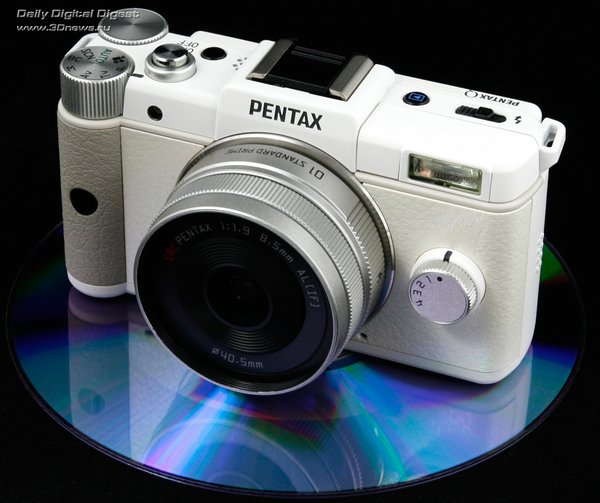
Even before getting to know the camera, it was clear that the Pentax Q is the record holder for dimensions in its class, and even Nikon 1 J1 and Panasonic LUMIX DMC-GF3 are losers here. Moreover, the camera is the lightest in its class. But only by holding it in your hands can you fully appreciate the tiny dimensions and minuscule weight of the Pentax Q, which gives odds to even many advanced compacts like Nikon Coolpix P7100 or Panasonic LUMIX DMC-LX5.

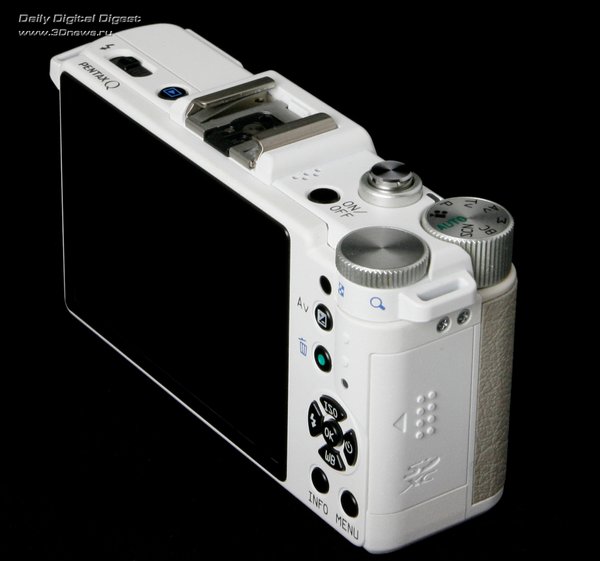
The camera body is made of magnesium alloy, and the front side is covered with a large rubber pad with a surface similar to leather. The build quality is impeccable, there is nothing to complain about.
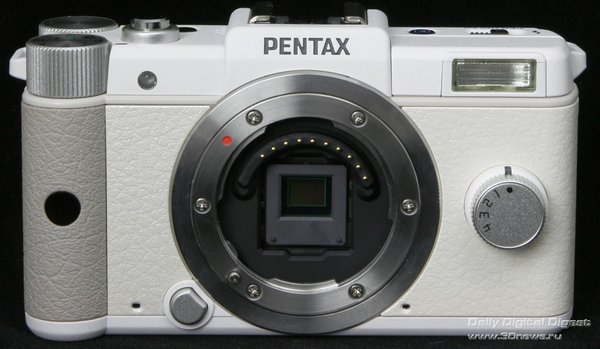
At the front is a Pentax q-mount mount, the diameter of which is approximately 2/3 of the diameter of a standard K mount, and the working distance is almost five times shorter. Also on the front there is a lens lock button, an IR sensor for the remote control, an autofocus illuminator lamp, which is also responsible for indicating the automatic shutter timer, a flash, a round customizable switch (selecting the aspect ratio of the frame, choosing a digital filter, choosing a color mode, and so on). There is also a pair of microphones located at the front, and they are installed at the bottom of the front panel on the sides of the bayonet mount.
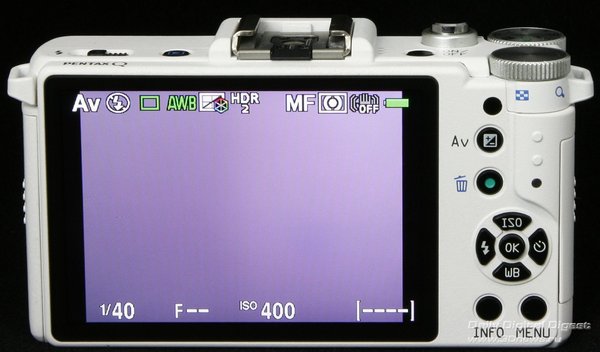
Most of the rear surface is occupied by the screen, to the right of which there is a button for introducing exposure shift, a programmable key, a standard set of multifunctional arrow keys combined into a schematic ring, as well as a button for selecting the display display mode and entering the main menu.

On top are the pop-up flash lock button, playback mode key, standard hot shoe, system speaker, power key, shutter key, shooting mode dial and control dial.

At the bottom there is a connector for mounting on a tripod and a rubber plug that hides the connectors for connecting AV/USB and HDMI cables.


View left and right
On the sides there are spring-loaded doors that hide the battery compartment (on the left) and memory card (on the right). Placing the SD card compartment on the side allows you to remove the memory card even if the camera is mounted on a tripod, which is very convenient.
PENTAX Q - Review
DSLR capabilities - compact size!
- Interchangeable lenses and flashes, just like a DSLR!
- Durable magnesium alloy body
- Miniature dimensions - case thickness is only 3.1 cm!
- Optical stabilization system SHAKE REDUCTION
- Highest quality video recording Full HD, MPEG-4
- Full range of manual settings
Awards/Reviews Find out more
Links
Description Find out more
Compact hybrid mirrorless camera Pentax Q
The smallest mirrorless camera with interchangeable lenses!
The first thing that strikes you when you get to know the PENTAX Q is its extremely small dimensions. The camera added one more fetish to the main fetishes of digital photographic equipment - miniature. The PENTAX Q may look like a stylish toy, but this amazing camera combines the size and ease of operation of a compact with the capabilities and image quality of a DSLR.
In terms of the number of control elements and interface logic, the Q is no different from younger models of Pentax SLR cameras (for example, Kr). The camera body is entirely made of magnesium alloy, which gives it not only reliability, but also an elegant appearance. And thanks to the good texture of the coating on the front panel of the camera and its light weight, the Q feels like a monolith in your hand!
PENTAX Q is available in a choice of white or black.
Latest Q-mount system
The PENTAX Q uses a completely new Q mount, the diameter of which is noticeably reduced to two-thirds the diameter of a conventional K mount. This was made possible thanks to the working distance shortened by almost five times compared to the K mount (the distance from the bayonet plane to the surface of the matrix), as well as optimization lens coating circle to match the compact image sensor. The Q-mount system also lacks an optical viewfinder, mirror unit and AF unit, making the PENTAX Q the most compact and lightest in its class.
The camera body is made of magnesium alloy, which gives it an elegant appearance with good surface texture, ensuring compactness, light weight and increased reliability.
Exceptional image quality

The PENTAX Q features a 1/2.3-inch back-illuminated CMOS sensor, delivering beautiful, detailed photos at approximately 12.4 effective Megapixels. This is made possible by an efficient light-gathering optical design that guarantees excellent sensitivity, low noise and high image data readout speed. PENTAX Q is also equipped with a new generation graphics processor, combining the best modern PENTAX technologies created and accumulated over many years of development of digital SLR cameras. The combination of this GPU with high-quality lenses specially designed for the Q mount results in sharp, high-contrast images with excellent color rendition and detail, including at the edges of the frame.
With reduced noise at high sensitivities, photographers can enjoy the entire range—from ISO 125 to high ISO 6400—without worrying about annoying digital noise. Using the HDR (High Dynamic Range) mode, a function for taking a picture from several frames with different exposures, allows you to easily create images with an extended dynamic range without underexposed and overexposed areas.
An innovative tool for creative photo editing
PENTAX Q offers a completely new style of photography. Using the new Smart Effect feature, which offers nine different visual modes via the quick-access control dial located on the front of the camera, photographers can easily add visual effects to an image and immediately see the results on the LCD monitor. The control dial has four positions, each of which can be pre-assigned to any of the “Smart Effect” modes. The already familiar “Custom Image” functions and digital filters have been improved, expanding the range of image processing capabilities. To tailor the PENTAX Q to the user's needs or specific shooting conditions, the control dial can also be assigned Custom Image settings, digital filters, or aspect ratio settings.
Smart Effect Modes
- Brilliant Color - creates a vibrant atmosphere by raising color saturation to its maximum value.
- Saturated unicolor (Unicolor Bold) - creates a high-contrast image, preserving one specific color in it.
- Vintage Color – Produces a retro “Toy Camera” effect, with multiple customization options.
- Cross Processing - creates unusual images with atypical color reproduction, similar to the result of the cross process** used in film photography.
- Warm Fade - creates low-contrast images with white balance shifted towards pink tones.
- Tone Expansion - Creates impressive images with a visual effect similar to an intense HDR effect.
- Bold Monochrome - Creates low key images with high contrast and increased sharpness.
- Water Color - creates the visual effect of a watercolor painting.
- Vibrant Color Enhance - Creates a colorful atmosphere with slightly increased contrast.
** Cross-processing is a technique in which film is deliberately treated with chemicals intended for another type of film. As a result, the photo acquires unusual shades and/or contrast.
Pentax Q: the world's most useless interchangeable lens camera
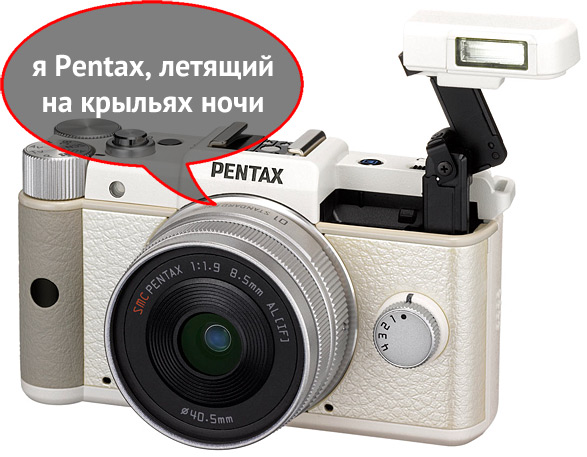
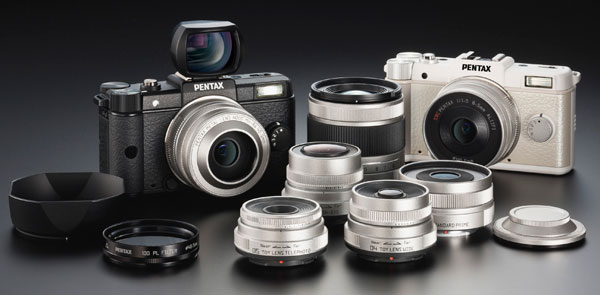
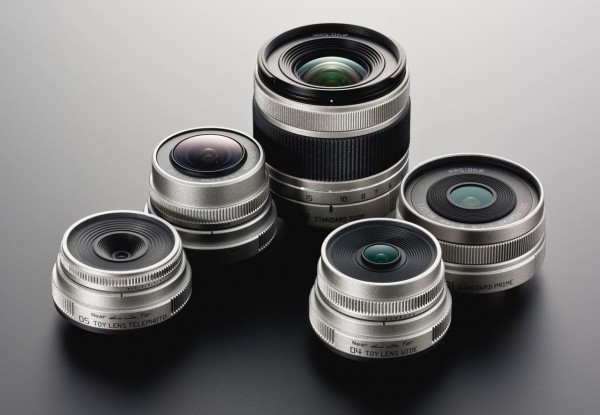
Subscribe to our fun channel on Telegram so you don't miss anything.
they shoed the flea again. managed. Well done. but why? The price of the lenses is included separately.
![]()
The inscriptions on the “Toy Lens” lenses are especially pleasing :-).
There may also be buyers who follow fashion - and now the fashion is for mirrorless cameras with interchangeable lenses :-).

Well, in the states there has always been a fashion for Lomography. as in the union for rangefinders. in general, it’s more about the crop factor and prices. Let's see what Nikon and Canon produce there. one of them (Nikon, it seems) promised to give birth to a mirrorless camera with a crop factor of 2.6. Canon is also strenuously scratching its head in this direction. and the point is in marketing, and not in the complexity of release. because against the backdrop of this exhibit, the GF3 Kunstkamera is quite a device.
![]()
But I liked the NEX-C3 more. There is a larger display, and most importantly, an APS-C matrix.

What is this going on in the world? Almost all (except Cupertino) technology companies I love have started producing crazy things (((((where are they going? Take away the coke and weed from them!
![]()
the flash on the bracket rules

I would not make such hasty and categorical conclusions, for the simple reason that if you “measure” this Q by the size of the matrix, it is obvious that this is NOT a MIRRORLESS with a typical 3/4 or APS-C matrix, but an ordinary compact. With such success, the Canon 5DMk2 can be called “the world’s most useless interchangeable lens camera for the most novice amateur photographer who wants to stand out from the crowd”, it is large, inconvenient, heavy and incomprehensible :) REAL HORROR. 🙂 But this Q can also be distinguished from a compact: a removable prime lens on a new matrix with backlight compensation will give many times better quality than any compact. Example on ISO 400 images: https://www.imaging-resource.com/PRODS/PENTAXQ/PENTAXQA7.HTM In principle, you can get an image at ISO 800 that is tolerant in detail and noise, suitable for A4 printing.
- We have a really small camera with interchangeable lenses (and this is in a compact)
- "Bokeh filter" should solve the problem with excessive depth of field (and it's better than compacts)
- Uncharacteristic detailing at low noise at ISO 400-800 (and this is worse for compacts - the details of a 1/2.33″ matrix are lost starting from ISO 100)
- The metal in the case is magnesium, not plastic (yes, it won’t scratch)
- The flash looks scary, but according to the plan there should be no “red eyes” (and again better than almost any compact)
- FISHE-EYE lens for compact! (must be really cool)
What's in the Bottom Line? It seems that this is a high-quality and expensive TOY for Europeans and Japanese, according to psychology for those who want to stand out among others. And this distinction is justified by the more expensive camera material, better hardware and software, higher quality photo and video results - all in relation to compacts, and the unusual ability to change optics.
The Pentax Q mirrorless camera, minus the matrix, is equipped with advanced electronics and developed functionality
Pentax Q is the funniest “system” compact of the year. It seems that it has no place here at all - with such a tiny matrix, funny lenses and a flash protruding to the height of the body. But the conditions are met: lenses change, controls are developed, and even a “hot shoe” on the roof for connecting external accessories is available.
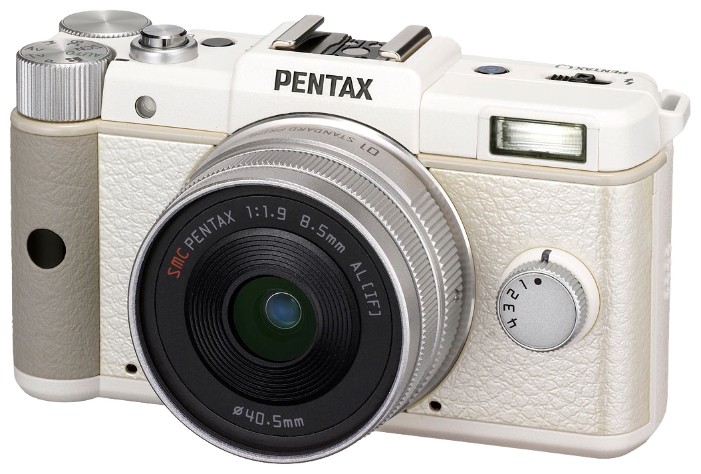
Resolution – 12.4 MP, Zoom – 47 mm, Display – 3″, F1.9
The idea is extraordinary, because the Pentax system uses a 1/2.3-inch form factor sensor that is disconcertingly small, even by compact standards.
This is the cliché of mirror quality in a compact package turned inside out. And here there are two opinions regarding the question “why?” The first says that Pentax is no longer able to compete with the main market players, but is trying to save face in areas where competition is obviously low.
This idea is confirmed by examining the company’s limited model range. Second opinion: yes, it’s just cool! If anyone doesn’t understand, take a look at the Lego camera, branded compacts with paper inserts under the front panel and in general, don’t be so serious!
The set of lenses presented simultaneously with the camera also speaks in favor of fun: out of five names, one is fisheye, and two more - 35 and 100 mm - are completely “toy”, i.e. they work like digital filters in modern cameras, only in an analogue way. The idea, obviously, is to create a compact and small camera for amateur photographers who are not looking for any special quality, but rather for relaxed creativity and fun pictures.
The design of the Pentax Q should hint at either small-film DSLRs or rangefinders, but with the flash raised it looks more like the robot Wall-E or Number Five from the movie Short Circuit. But Pentax engineers managed to do what Nikon failed to do: create a truly compact “system” camera based on a compact matrix. Q is truly the smallest, noticeably smaller than past champions Sony NEX, and weighs only 200 grams.
The electronics of the camera are quite serious. The small sensor is the most advanced type of BSI CMOS (i.e. back-illuminated) sensor, featuring high sensitivity (up to ISO 6400) and speed (5fps in burst mode). There is video recording at 1920×1080 pixels with H.264 encoding.
Display with a diagonal of 3 inches and a resolution of 460 thousand dots. The functionality in the controls and interface is not inferior to SLR devices: in addition to a full set of options for manual shooting control, there are advanced modes such as depth of field control and almost an entire graphic editor with a variety of effects and filters.
So, minus the matrix, the camera is equipped with quite serious and advanced electronics and developed functionality at the level of modern DSLRs. There is even some excess, because in general the system competes - of course, not with other “system” devices, but rather with older compacts like the Olympus XZ-1. The capabilities in this class are approximately the same, the quality of the images is the same, but on the Pentax Q you can install a more suitable lens at any time.
There is one more pleasant advantage in this funny system. The camera itself, while not particularly cheap, will certainly not be too expensive. And lenses, especially “toy” ones, as the developer promises, will be sold cheaply. For amateur entertainment, this is an important quality. In general, the Pentax Q does not compete with “system” cameras, but rather with advanced compacts like the Olympus XZ-1. The capabilities of these cameras are approximately equal, the quality of the images is similar, but on the Pentax Q you can install a lens that is more suitable for the situation at any time.
New system (mirrorless) camera from Pentax - Q7
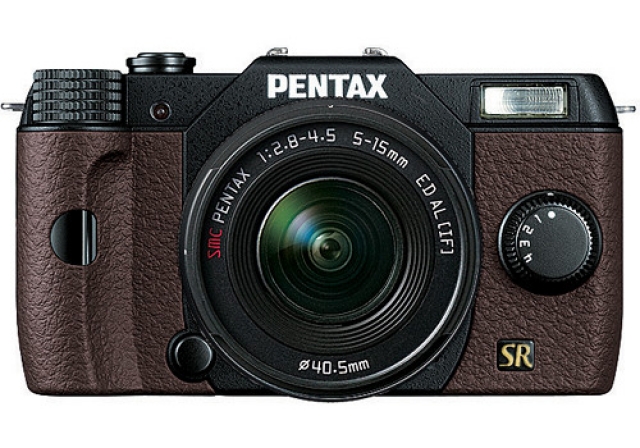
Pentax has released a new mirrorless camera in the Pentax Q line. While leading system camera manufacturers like Sony and Olympus were producing advanced mirrorless cameras, Pentax took a chance and released the original Q back in 2011. The camera had a rather unconventional appearance for a system camera with interchangeable lenses, and did not gain popularity among photographers. However, Pentax has announced an updated model called the Pentax Q7 .
Pentax Q7 Brief Review
Many photographers consider Pentax Q products too expensive, but despite this they are quite productive and of high quality. One of the main competitors of the new model is the Nikon P7700 camera. At the same time, Pentax has interesting advantages that can certainly attract potential customers. For example, the Q7 can be ordered in any of 120 color combinations. This way you will have the opportunity to make your camera either very stylish or very funny.
The previous mirrorless model was equipped with a 1/2.3-inch matrix. The matrix of the new Q7 has become slightly larger, its size is 1/1.7 inches. The resolution is 12 megapixels and the light sensitivity is up to 12,800 ISO. Interestingly, all modern Pentax Q lenses are designed for cameras with a large sensor and provide a slightly wider field of view compared to older cameras.
Along with the new camera comes a new lens. The equivalent focal length of the new optics is 50 mm. The aperture number corresponds to F/9. The model will cost just under $80.
List of key characteristics of Pentax Q7:
- 1/1.7 inch BSI CMOS sensor with approx. 12 megapixels
- ISO sensitivity up to 12800
- 3-inch screen with a resolution of 461 thousand dots
- Continuous shooting at 5 fps
- RAW support
- Shutter speed up to 1/2000s
- Weight 200 grams
- Image stabilization
- Capable of recording high-quality Full HD 1080p30 video.
Pentax Q7 Official Press Release:
Available in 120 color combinations, the Q7 ensures you have a camera to suit every taste and style.
Denver, CO (June 12, 2013) PENTAX RICOH-IMAGING Americas Corporation announced the availability of the Q7 mirrorless camera. Available to order in 120 attractive color combinations. The Q7 gives you creative control with its unique lens, fun filters and creative effects.
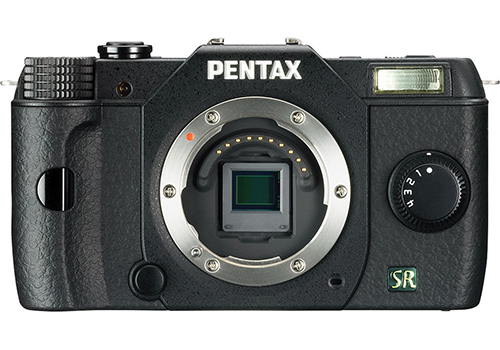
A mirrorless camera can achieve great popularity thanks to the ability to create an individual style and show your individual taste. The Q7's 1/1.7-inch back-illuminated CMOS sensor provides excellent image quality. Light sensitivity ranges from ISO 100 to 12,800. Other positives include increased focusing speed and camera response.
“The Q7's small size and 120 color options go a long way,” said Jim Malcolm, executive vice president of PENTAX RICOH imaging. “This incredibly tiny mirrorless camera packs a lot of impressive specs and creative capabilities, including a range of digital filters and effects.”
Weighing only 200 grams, the compact body of the Q7 allows you to take the camera with you on any trip, and the presence of original filters makes the shooting process more fun. 19 smart effects and filters will give your photos a unique and original style, while the image quality will be very impressive. Plus, with the Q7's Eye Fi SD card compatibility, you'll be able to edit, resize, and share photos instantly.
Along with the new camera, a lens with a fixed aperture F9 and a focal length of 11.5 mm (or 53 mm in 35 mm format) will be available for sale. Shooting with this unique optic will result in stunning images with pronounced edges. Thanks to the focusing range of about 0.7-2m, we can assume that still lifes and macro photographs will have a fabulous, incomparable look. The model weighs only 8 grams, and in appearance it simply resembles a lens cap, and not the lens itself, this makes the new optics an ideal option for the traveler. The camera and lens can easily fit into your pocket.
Pentax Q-S1 - Baby in Action
3 years ago, the photography world was shocked by the world's smallest mirrorless interchangeable lens camera, the Pentax Q, which featured a modest 1/2.3'' sensor and stylish retro design. Since then, the line has already received two updates, the largest of which was the Pentax Q7, which received a 1/1.7'' matrix, which, you see, is very difficult to call a revolution.

The new Pentax Q-S1 replaces the Q7, but doesn't bring any noticeable changes other than an updated design. Will it be able to win the hearts of users, or will it become just another “toy” from the Q series?
Design
The Pentax Q-S1 is made of high quality plastic textured to resemble leather. There are two dials on the front panel: the first, to the right of the lens, is designed for quickly switching between modes, and the second, the one on the left, is for adding aesthetics and a more comfortable grip. The top and rear panels feature a range of mechanical controls that not only give you more control when shooting, but also add style and elegance to the camera's appearance.
The built-in flash has a retractable design. The 3-inch LCD display is not impressive in terms of clarity: only 460,000 dots. The display is equipped with a special anti-glare layer, which is not particularly effective, since the image still remains difficult to view under direct sunlight. To make matters worse, the display is not touch-sensitive or rotatable. The now popular Wi-Fi, NFC and GPS modules are also absent here, which makes it feel like this camera really came from somewhere in the 70s.


Memory card slots, miniHDMI and AV ports are on the right side of the Q-S1, and the battery compartment is on the left, so you can easily and quickly access these elements even when using a tripod, which, by the way, is mounted from below.
The case dimensions are only 104.1x58.4x33 mm, the device remains very compact, but, unfortunately, is no longer the most compact on the market. The included Pentax 02 5-15mm zoom lens is too large (48.26×48.26 mm) for its characteristics, which is why the Q-S1 will have to compete closely with the advanced Sony RX100 III point-and-shoot camera, which, unlike the hero of this review, equipped with an OLED electronic viewfinder, and with a mirrorless Panasonic Lumix GM1, the main advantage of which is a large Micro 4/3 format matrix.
There are 5 body color options and 8 handle colors available, so each user can choose the combination that best suits their style.

Image quality
Inside, the Q-S1 is exactly the same as its predecessor, the Pentax Q7, with a 12.4-megapixel 1/1.7'' back-illuminated CMOS sensor and Q Engine image processor, but despite this, the image quality is higher. Light sensitivity is adjustable within the range ISO 100-12800. As ISO increases, the difference between the two cameras becomes more apparent, with images taken on the Q-S1 having more detail and more accurate color reproduction, which is likely due to improved processor algorithms.
Autofocus is relatively fast, especially for a camera of this size. It uses contrast technology, complemented by facial recognition and motion tracking. Unfortunately, this will require selecting the appropriate modes, which will take away precious seconds. Pentax also added an LED AF assist lamp to the Q-S1 for faster focusing in dim rooms.


Pictures taken with sensitivity up to ISO 800 are almost free of “digital noise”; noise begins to appear in pictures taken at ISO 1600, but the pictures themselves will remain quite usable. At the same time, ISO 3200 is a fine line, after which the pictures become completely unusable.
From time to time, chromatic aberrations will appear in the photographs, but their amount is so small that you can close your eyes to them.
Video recording can be carried out in Full HD 1080p resolution at 30, 25 or 24 frames per second. The settings include a continuous autofocus mode, the operation of which is clearly audible, so manual focusing using the ring on the lens was just in place. During recording, manual adjustments will be limited to changing ISO sensitivity and a few filters. In general, in terms of video, the Q-S1 has practically no improvement over its predecessor, except for the addition of continuous autofocus, although the presence of fully manual control and shooting at 60 frames per second would have been useful.


Conclusion
The Pentax Q-S1 not only has a beautiful cover, but also quite good hardware, which allows you to take high-quality pictures with proper skill. At the same time, if you are looking for a compact mirrorless camera with decent image quality, then the Q-S1 has a whole flock of competitors: starting with Nikon 1 and Samsung NX Mini, and ending with Panasonic GM1 and GM5, although Pentax will be able to give a strong rebuff to each of them some parameters. I would confidently recommend this new product to anyone looking for a compact camera with a truly stylish design and a wide range of affordable optics.
Timur Bublik
Specially for Fotosklad.ru
















